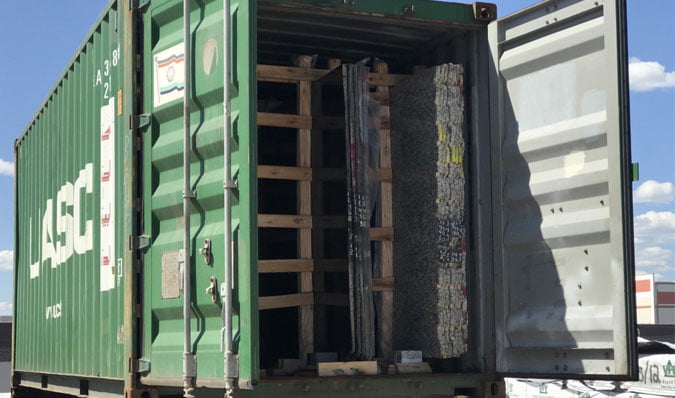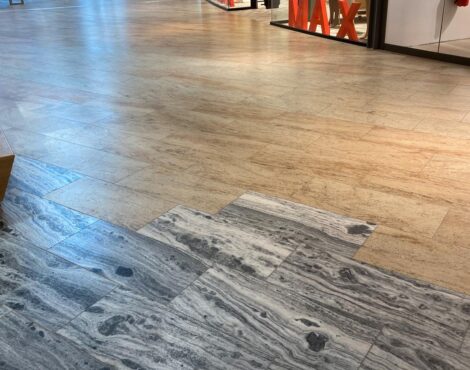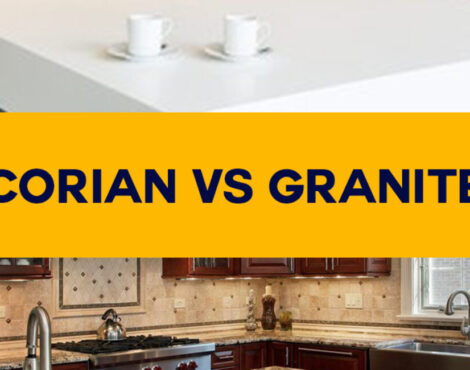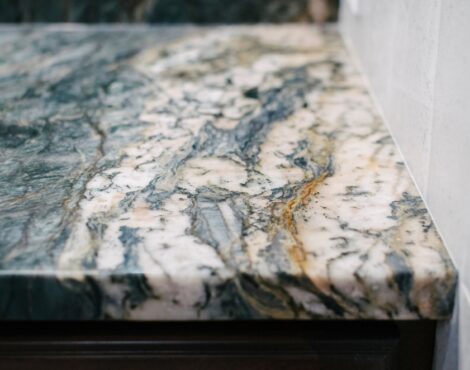Ever wondered why granite is predominantly shipped in containers? Shipping granite in containers is a popular choice for many reasons mainly as it provides practical benefits regarding protection, standardisation, and efficient logistics.
Containers offer a safe and protected space, ensuring that granite slabs are shielded from outside factors and potential harm while being transported. The standardised sizes of containers, like 20 feet and 40 feet, allow for compatibility with different modes of transport, making it easier to handle, stack, and load/unload. Maximising space utilisation through efficient container packing can significantly lower shipping costs and minimise the need for multiple shipments.
In addition, containers facilitate intermodal transport, enabling smooth transfers between ships, trucks, and trains. The secure and efficient transportation of granite is greatly enhanced by the container’s advanced security measures, tracking capabilities, and adherence to customs regulations.
Furthermore, the weight of granite plays a crucial role in determining the most suitable shipping method. Due to the significant weight of granite slabs, air transport is typically not feasible due to the expensive expenses involved. Shipping containers are highly durable and come in standardised sizes, making them an excellent choice for transporting heavy materials such as granite over long distances. They provide a cost-effective and practical solution, ensuring efficiency and affordability in the shipping process.
Now that we have an understanding of why granite is commonly shipped in containers between countries, let’s explore the prevailing standard sizes of these containers.
How Big Is A Standard Shipping Container?
There is a wide range of sizes available for shipping containers, with 20 feet and 40 feet being among the most commonly used lengths. Provided below are the standard dimensions for these two sizes:
-
20-foot Container
- External Dimensions: 20 feet long, 8 feet wide, and 8.6 feet high (6.10m long x 2.44m wide x 2.59m high)
- Internal Dimensions: Approximately 19.4 feet long, 7.9 feet wide, and 7.10 feet high (5.898m long x 2.352m wide x 2.393m high)
- Capacity: Approximately 1,151 cubic feet / 32.6m3
- Maximum Payload:
- Approximately 52,910 to 61,730 pounds
- Approximately 24,000 to 28,000 kilograms
- Approximately 24 to 28 metric tons
-
40-foot Container
- External Dimensions: 40 feet long, 8 feet wide, and 8.6 feet high (12.19m long x 2.44m wide x 2.59m high)
- Internal Dimensions: Approximately 39.6 feet long, 7.9 feet wide, and 7.10 feet high (12.025m long x 2.352m wide x 2.393m high)
- Capacity: Approximately 2,390 cubic feet / 67.7m3
- Maximum Payload:
- Approximately 61,730 to 66,140 pounds
- Approximately 28,000 to 30,000 kilograms
- Approximately 28 to 30 metric tons
It’s worth mentioning that there are different sizes available, including specialised container sizes like 10 feet, 45 feet, and high cube containers that have extra height (The height measures 9.6 feet, which is a foot higher than the standard height of 8.6 feet).
The dimensions given are standard ISO container sizes, which enable convenient stacking and transportation on different modes of transport, including ships, trains, and trucks. Container sizes can differ slightly based on the manufacturer and design. To ensure accurate measurements, it’s recommended to review the specifications of the specific container.
How Many Granite Slabs A Shipping Container Can hold?
Several factors determine the number of granite slabs that can be held in a shipping container. It’s important to consider more than just the dimensions of the slabs and the container. The type and density of stones are crucial factors that significantly affect the weight of slabs, as different stones have different densities. It is crucial to take into account the specific density of the granite being shipped. In addition, the weight of granite packaging materials, like crates or pallets, adds to the overall cargo weight. Maximising the number of units loaded into the container relies heavily on efficient packaging practices.
Furthermore, it is crucial to prioritise compliance with logistics and transportation regulations, considering the differences in shipping regulations both globally and within a country. Having a clear understanding of these regulations is crucial when it comes to determining the maximum amount of stone that can be placed in a shipping container.
- When it comes to European destinations, we consistently load 24 metric tonnes into the container.
-
When it comes to shipping to the USA, we consistently load 21 metric tonnes into a 20-foot container.
Let’s attempt to answer the question by using the average as a baseline.
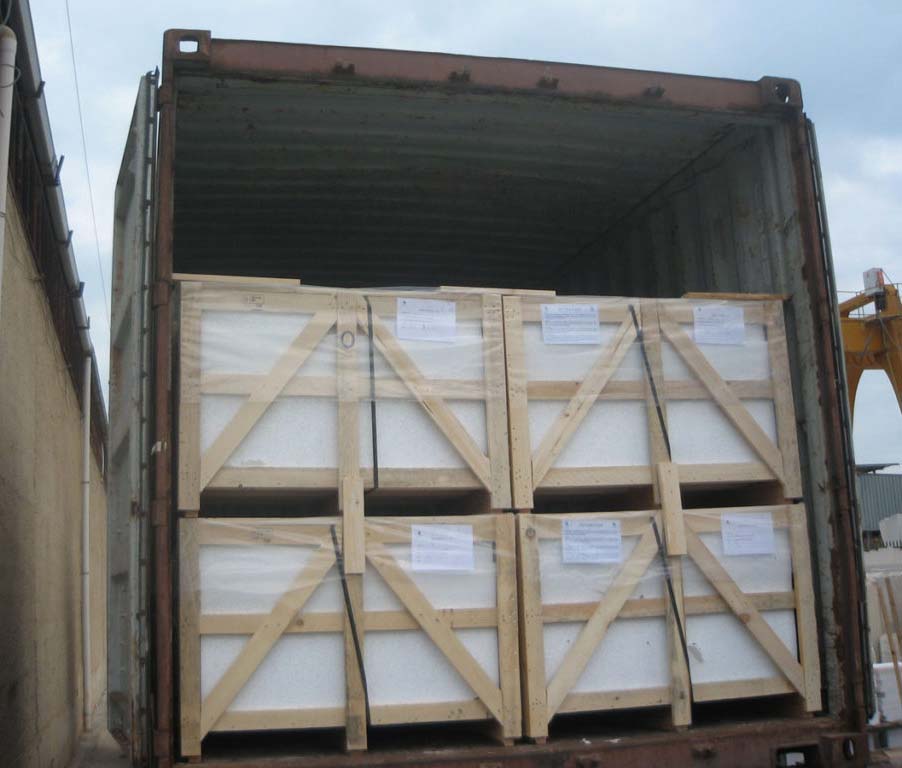
Gangsaw Slabs Bundles
The weight of a slab with a thickness of 2 or 3 cm can vary depending on the specific type of stone, its density, and various other factors. However, for a rough estimate, you can follow this general guideline:
READ | Understanding the Weight of Granite Slabs
- 2 cm (0.79 inches) Thickness:
- A 2 cm thick slab of granite can weigh approximately 5 to 6.50 kilograms per square foot.
- 3 cm (1.18 inches) Thickness:
- A 3 cm thick slab of granite can weigh approximately 7 to 8.50 kilograms per square foot.
To calculate the weight of a specific slab, you can use the following formula:
Weight = Area (sq ft) × Weight per sq ft
Granite slabs are bundled during loading in containers for efficient transportation, protecting slabs from damage, optimizing space, and streamlining handling processes. This bundling ensures secure transit, ease of identification, and compliance with safety regulations.
- Average Bundles per Container:
- 7 bundles
- 3 at the back and 4 at the front
- Maximum Bundles per 20′ Container:
- 8 bundles
- 4 at the back and 4 at the front
- Minimum Required Bundles per Container:
- 6 bundles
|
Criteria |
2 CM Material |
3 CM Material |
|
FCL Weight |
28 tonnes |
28 tonnes |
|
FCL Bundles |
8 to 10 bundles |
7 to 8 bundles |
|
Slabs per Bundle |
9 to 11 slabs |
7 slabs (Generally) |
|
Avg. Salb/Container |
72-88 Slab |
49-56 Slabs |
When customers purchase more than 8 bundles, the slabs from the additional bundles are usually distributed among the remaining 8 bundles.

The Storage Capacity For A 20-foot Container Based On Different Thicknesses Of Tiles And Slabs
Slab Capacity
Tiles capacity:
1. 18 mm Tiles: – 460 – 500 sq. Meters OR 4951.44 – 5382 sq. Feet
2. 20 mm Tiles: – 440 – 470 sq. Meters OR 4736.16 – 5059.08 sq. Feet
3. 30 mm Tiles: – 270 – 300 sq. Meters OR 2906.30 – 3229.2 sq. Feet
4. 10 mm Tiles: – 800 – 820 sq. Meters OR 8611.20 – 8826.48 sq. Feet
5. 12 mm Tiles: – 650 – 670 sq. Meters OR 6996.6 – 7211.88 sq. Feet
Stone Galleria – Granite Supplier
Discover the meticulous technique of granite loading at Stone Galleria. Our team of experts is dedicated to maximising space utilisation and carefully balancing weight distribution, providing the utmost protection for your shipment. Reach out to us now for professional solutions that enhance your granite logistics experience.
We are really excited to share that we have been recognised on Feedspot’s “80 Best Granite Blogs and Websites” list.

